Genre: Fighting Developer: GameTek Publisher: GameTek Players: 1-2 Released: 1994
There seem to be, with a few exceptions, of course-three types of games: those that clone, those that refine, and those that innovate. Brutal: Paws of Fury does all three. It’s obviously a clone of Street Fighter II, designed specifically with the intent of riding the wave of money it created in the early nineties. But it also refines the fighting mold by adding all sorts of bells and whistles, along with back stories and philosophy that are actually interesting. Lastly, it’s innovative in that it implements a learning system and password scheme that really motivates the gamer to play it all the way through.
The storyline is typical for a fighter-a big martial arts master sends out a call for all the best warriors from around the globe to come and vie for the title of World Champion. Only instead of M. Bison running the show it’s…a llama? That’s right, that ancient and sage oriental guru, the Dali Llama, is calling the shots.
In case you couldn’t figure this out from the title, Brutal is not your average fighter. You won’t be playing as underdressed and overendowed women, muscle-bound men, or monsters. You’ll be playing as any of a cast of eight animals: a rabbit, cheetah, coyote, rat, lion, fox, bear, or (with a cheat code) the Dali Llama himself. Each one sports his or her own philosophy, fighting style, personality, array of special moves, and complex ‘Katas’ – highly dangerous and automatic combos. Don’t expect to get to unleash all of that power right away, though. At the start of a one-player game you have absolutely no special moves at all. Only by defeating opponents and showing yourself worthy will the Dali Llama descend from his mountaintop to teach you. Translation: beat two opponents, earn a move. At first you learn taunts, then special attacks, then Katas. Once learned, these moves can be used at any time after that – provided you enter a password.
There’s one thing about that last detail. At the start of the game you can enter a password, choose to start a new game, change a bevy of options, or engage in a ‘no frills head-to-head’ with a second player. I thought at first that the password system would allow you to resume play at the stage you reached the last time you played. Logical conclusion, of course – that’s the way it always works, right? I was mistaken. Innovation time, folks.
After defeating an opponent, you get a password, but when you enter the password, you don’t get to restart where you left off. You go all the way back to the beginning of the game, only this time you have all of the special moves you learned in addition your current win/loss tally and belt position. (As you win bouts you advance in rank, all the way from the lowly white belt to the prestigious 6th Dan.) Better yet, you can then enter that password into the two player head-to-head mode so you can trash your friends with your master warrior. So you can see that, if you want to invest the time, there’s a lot of stuff to earn and master in this game. But is the game itself good enough to warrant the attention needed to excel?
Graphically, Brutal is exceptional in its own way. There aren’t many special effects or dazzling backgrounds, but what we do have is excellent, colorful art that is definitely easy on the eyes. The animation is even better; it’s truly impressive. I challenge anyone to watch Foxy Roxy walking and tell me that Brutal has bad animation. The manual claims that each character has over 200 frames, and I can easily believe it. Other fighting games that sport the more technologically advanced motion capture digitized art (like Mortal Kombat) may have been more ‘realistic,’ but you just can’t beat hand animation of this caliber. Extra big kudos to Gametek for their work in the graphical department.
The sound, however, is not so good. There are a few good voice synthesis clips early on – “Sega!” and “Brutal” – but after that it really goes downhill. It’s as if Gametek filled the cart up with animation frames and didn’t leave any room for sound, because there’s only one fighting tune and all of the characters make the same noises. Yes, this is one of those games where the female characters sound just like the male ones, and it’s disturbing. I would have enjoyed hearing different grunts, war cries, and howls for each of the characters. The sound effects are good, but once you have to listen to them for every character, they get repetitive, the same with the music. After a few menu tracks, there’s only one or two battle tracks. They’re okay themes, I suppose, but again: they really needed a different song for each character. As it is, you have to listen to those tunes waaaaaay too much, and it starts to become extremely grating after a bit of playtime. Once you combine cruddy sound with uninspired, repetitive music, you find that Brutal is one of those games that is best played with the volume to zero and your favorite album going beside you. You won’t be missing anything.
The controls are a bit better. The characters react pretty quickly to your commands, and the key layout is that of your standard fighter setup: X, Y, and Z are punches; A, B, and C are kicks (for those of you unfortunate enough to have only a three button pad, then you’ll have to use Start to switch between the two). It’s all pretty generic: backwards plus a button is a roundhouse, down plus a heavy kick is a leg sweep, back and down is a block, up is jump, yadda yadda yadda. No innovation here. The controls are set up like every other 16-bit fighter out there, and problems start to arise in the controls when you get to the special moves. The bottom line is that they’re hard to pull off. Whereas the normal moves are pretty responsive, it seems to be hit-and-miss with the specials, more so with the complex Katas. You’ll find yourself getting creamed a lot as you try in vain to get your fighter to do a special.
A side note here: there aren’t any limits on specials. You can use each one infinitely, which means unsportsmanlike opponents and even the computer will just corner you and special you to death. Definitely a flaw in the setup. Any game which allows the computer to charge you over and over with invulnerability is frustrating. You’ll see what I mean in Rhei Rat’s stage.
Which leads me to the difficulty level of this game. Pardon the cheap pun, but Brutal is simply brutally hard. I know that fighters have a rather steep learning curve and that they require a certain amount of time before you start winning, but still… Even set on the easiest difficulty, it took about 45 minutes before I won my first bout. Compare that to Eternal Champions or Street Fighter II, in which you can usually pick up a controller and get at least a few stages in on the easiest difficulty. In Brutal, the computer opponents have a full array of special moves at the beginning even when you have none, and once you combine that with the CPU’s tendency to special you to oblivion, you get a hair-pulling experience and a near vertical learning curve.
The bottom line is that Brutal: Paws of Fury is the epitome of mediocrity, the essence of a mixed bag. It succeeds visually, but it fails in the audio department. It’s a great game as far as personality and uniqueness goes, but as a fighter it falls short of its goal. Two positives, two negatives. You could certainly do far worse than Brutal, even in the fighter category, but you could also do far better. It’s a cheap game, and it will even keep you entertained for a week or two, but it doesn’t possess the depth and sheer fun-factor needed to make it a staple of your library.
SCORE: 5 out of 10

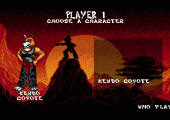
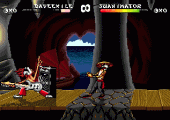
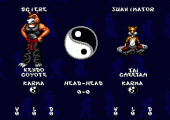
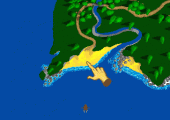
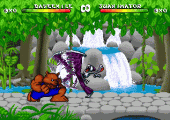
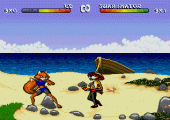
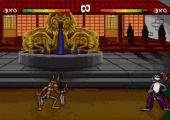
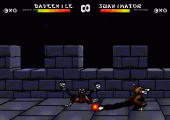

Recent Comments